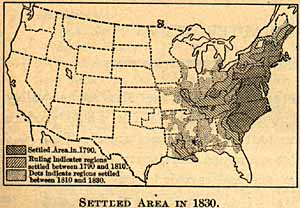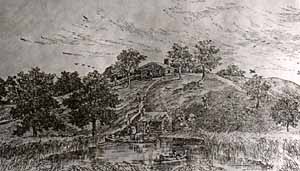The Wilderness Home

The wise pioneer chose land on a lake, a stream, or a bay. It was important
for him to have a water supply. If he chose part meadow land and part forest land, he
had an easier time building the log cabin and planting the first crop. In choosing a
place for a home, he kept in mind the need for protection from the Indians and from
storms.
The newcomer began by chopping the small undergrowth. The smaller trees
he killed by burning them about the roots or by using an ax to take off a strip of bark
all around the tree. This was called "girdling" the tree. The logs he did
not use for a cabin he put together and burned just to get rid of them. What good use
could be made of that timber today!
The first home was often any shelter that could be found. One Norwegian
family lived in a haystack for three months. How fine the log cabin must have seemed
when it was finished, even if it had only one room! But when winter came, we may be
sure that the snow sifted onto the floor and over the beds.
Logs for the walls were fitted and plastered together. Floors were
often made of earth, stone, or logs split lengthwise. Sometimes screws or wooden pegs
were used instead of nails. Roofs were of stone, clay, boards, or brush. A second room
was sometimes made in a low attic, which was reached by a ladder or by wooden pegs driven
into the wall.

Doors were made from thick boards laid lengthwise and held in place
by cross strips and wooden pins. Leather or heavy wooden hinges were used. A wooden
latch fastened on the inside was opened by a strip of buckskin that hung through a hole
on the outside. Many of the early pioneers used greased paper or deerskin or bearskin
for the windows. A few of the better cabins had glass.
The fireplace was the most important spot in the cabin, for it was
used to heat the home and cook the food. The room was lighted by burning big sticky
pine knots, by candles, or by wall lamps made from clay in the shape of a cup. Bear's
oil and deer's fat were burned in these lamps.
The first-floor room, with its heavy handsome furniture, was used in
many ways. Here the first church services were held. When a Catholic priest or a preacher
on horseback came near, the news traveled like lightning. The cabin was swept, benches
were set up, often a chest was made beautiful to serve as an altar--all on short notice.
Soon the little dwelling became a church.
The cabin was also the first country school. Sometimes the mother of
a family was the teacher of a "pay" school. Before Wisconsin became a state,
these schools were supported by the parents of the children enrolled in them. One man
sent three of his children to school and paid fifty cents a week as his share toward
the teacher's salary of fifteen dollars a month. In some places the first teachers were
French priests.
Many parties were held to get work done in a pleasant way. There were
log-rollings, house-raisings, husking bees, wood-chopping parties, and quilting bees.
How would each kind of party help the early settler?
|



